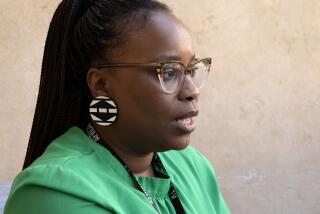‘My Atomic Aunt’ and other docs bring foreign cultures to American audiences
Echoes from foreign lands have been edging deeper into the American imagination. Terrorism, financial meltdowns, wars and refugees spin out in real-time news, recurring glimpses of ancient transgressions that at once divide and bind us.
But hand-held cameras, lap-top editing and video streaming have afforded documentary filmmakers a wide expanse to bring intricate, indigenous stories to global audiences.
The languages are different, the cultures diverse, but each tale is a small, personal and fleeting chapter on a planet of 7.4 billion people: The fisherman in Borneo shares a bond with the cod chaser in the North Atlantic; the Syrian war refugee is kin in spirit to those trapped long ago in Cambodia’s genocide.
“We’re trying to bring in stories from parts of the world that Americans may only get snippets from in the U.S. press,” said Chris Hastings, executive producer of the World Channel, which began a series last month called “Doc World,” dedicated to foreign documentaries. “You get to see what the world is like in long form. There’s a diversity of ideas and voices bubbling up” from filmmakers in other countries.
Regret for a lost way of life resonates through “Surviving the Tsunami: My Atomic Aunt”, which airs on “Doc World” on Oct. 30. The home of filmmaker Kyoko Miyake’s aunt, Kuniko, became a forbidden zone on March 11, 2011, when a tsunami caused a radiation leak at the nuclear reactor in Fukushima, Japan. Kuniko’s bakery, funeral home and wedding business were shuttered. She was forced into temporary shelter but had faith that the Tokyo Electric Power Co. would quickly scour the contamination and send her home. But her anger grew as months passed.
Darling, don’t you realize we’ve been abandoned?
— Filmmaker Kyoko Miyakeâs aunt, Kuniko
The prospect of nuclear power had years earlier divided the residents of her dying fishing town, Namie. After pressure and debate, the villagers eventually supported the plant and its jobs as a way to survive. But as Kuniko slipped into a white protective suit and walked deserted streets — past abandoned cars and a “mountain of spooky black bags” — she realized she would never again pick blueberries from her garden or throw a wedding in her chapel.
“Darling,” she said to her husband, “don’t you realize we’ve been abandoned?”
Netflix, HBO Now and other outlets offer hundreds of international documentaries. A number of festivals, including Sundance, highlight such films. Of the estimated 154 docs expected to be shown in March at the American Documentary Film Festival in Palm Springs, about half will be international. It is difficult to quantify how many foreign documentaries are produced each year, but Simon Kilmurry, former executive producer of the “POV” series on PBS, said from 1999 to 2015 the number of all documentaries submitted to the program each year rose from 400 to 1,400.
“What I’ve found is that our Hollywood brothers have tended not to look at documentary films as revenue generators,” said Teddy Grouya, founder of the American Documentary Film Festival, who travels to festivals around the world including one in Kosovo. “But Netflix and other platforms are changing that mentality. This is good story telling. It’s not just talking heads. They’re story driven.”
Vice Media, which broadcasts investigative and gonzo journalism, including short documentaries on global warming and cannibal warlords, is vested in global storytelling. Vice, which has partnered on projects with A&E IndieFilms and HBO, operates in 30 territories, including in Mexico City, Tokyo and Berlin. Its film division recently started a unit dedicated to feature-length docs.
“Kids are walking into [our offices] and saying, ‘We have a documentary,’” said Eddy Moretti, Vice’s chief creative officer, noting that audiences are less resistant to subtitles and are increasingly drawn to foreign-language documentaries and scripted series. “There’s a growing interest, passion and fascination around amazing films coming from all over the world. … It’s some kind of global zeitgeist phenomenon.”
One documentary Moretti described as “pushing the art form forward” is “Credit for Murder” by Israeli filmmaker Vladi Antonevicz, who investigates neo-Nazi hate crimes, including the killing of two men, one of them beheaded, in a forest outside Moscow. The film, which some critics have likened more to a Hollywood thriller than a documentary, is a tale of truth and obsession that leads into darker reaches of Russian radicalism.
“Doc World” opened last month with the “The Killing Fields of Dr. Haing S. Ngor.” The physician and actor, who won an Academy Award for supporting actor for his performance in the 1984 feature “The Killing Fields,” survived Cambodia’s mass murder but was later shot and killed in downtown Los Angeles. Other films in the series deal with individual stories threaded with history, social justice and the environment, themes that are increasingly sought after.
“The market for international documentary films is incredibly competitive. You might end up getting in a bidding war,” said Hastings, whose channel is programmed by WGBH in Boston and is funded by the Corp. for Public Broadcasting, the Ford Foundation and others. “Amazon, HBO Now, Vice and Netflix are looking to buy because they have platforms to fill. Everyone is looking for something cinematic that looks pretty. But the personal story is the big thing.”
The personal is told in “Kismet,” a tale of how liberated, unveiled female characters in Turkish soap operas have inspired women in stricter Muslim countries to challenge societal boundaries.
The film, which airs on “Doc World” on Sunday, follows a young woman whose legal complaints in Egypt forced the government to stop the intimidating practice of “virginity tests” on anti-government protesters. A wife in the United Arab Emirates divorced her husband after watching the soap “Fatmagul,” about a character who was raped and took her case to court.
“She showed me that a woman can claim her rights,” said Samar Shaaban. “Why can’t I do the same?”
“Kismet” is told against the mosaic of an unsettled region. Regarded as one of the more open Muslim societies, Turkey, under Islamist President Recep Tayyip Erdogan, is growing more rigid, which may threaten the progressive dramas it is exporting from Chile to Lebanon to Indonesia. Portrayals of strong and sultry female characters offer escape and a redefining of Islam and tradition that have entranced viewers in more conservative Muslim countries. The lure of such provocative images has alarmed clerics.
“These series that some people consider modern and civilized are disastrous,” a bearded Islamist marriage counselor in the U.A.E. said in “Kismet.” “Whoever watches them will regret it.”
A militant version of that sentiment is at work in “Among the Believers,” which probes the Islamic fanaticism that has shaken Pakistan. Told through the prism of a madrassa network that included 10,000 students, the film examines the ideology of chief cleric Maulana Abdul Aziz Ghazi and his pursuit of imposing sharia law across the region. It’s a story of dangerous faith and misguided politics, including U.S. policy that once supported Afghan mujahedin — some were invited to the White House by President Reagan — against Soviet troops in the 1980s.
The documentary, which airs Oct. 16, begins with a boy standing before Ghazi and proudly reciting a warning to infidels: “We will destroy you if you attack us. You cannot enter here. You cannot conquer us. You cannot. And if you dare to enter here, we will destroy you in the name of jihad.”
Ghazi, who will later be arrested after a deadly military siege at a mosque, looks into the camera: “Allah willing, they [his students] will bring revolution to the whole world.”
That fierceness collides with more moderate voices who see the madrassas as imperiling Pakistan’s security but also its education system and economy. For Americans wanting to understand the resolve and perverted religion of terrorism, “Among the Believers” shines a chilling light on a country that veers between ally and enemy.
See the most-read stories this hour »
Twitter: @JeffreyLAT
More to Read
Only good movies
Get the Indie Focus newsletter, Mark Olsen's weekly guide to the world of cinema.
You may occasionally receive promotional content from the Los Angeles Times.











